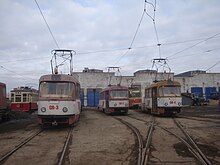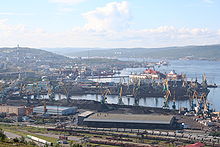Transport in Russia

The transport network of the
Russia has adopted two national transport strategies in recent years. On 12 May 2005, the Russian Ministry of Transport adopted the Transport Strategy of the Russian Federation to 2020. Three years later, on 22 November 2008, the Russian government adopted a revised strategy, extending to 2030.
The export of transport services is an important component of Russia's GDP. The government anticipates that between 2007 and 2030, the measures included in its 2008 transport strategy will increase the export of transport services to a total value of $80 billion, a sevenfold increase on its 2008 value. Foreign cargo weight transported is expected to increase from 28 million tonnes to 100 million tonnes over the same period.
Aerial cableway

In 2012, the cableway connecting Nizhny Novgorod and Bor was launched.[1] The length of the cableway is 3.5 km (2.2 mi). It has the largest unsupported span in Europe above the water surface is 861 metres (2,825 feet). The main purpose is to provide an alternative type of passenger transportation in addition to river taxis, electric trains and buses.
Rail transport
Russia has the world's third-largest

Russian Railways, the state-owned national rail carrier, is one of the world's largest transport companies, enjoying a monopoly over rail transport in Russia. Established in 1992, it employs an estimated 950,000 people, and accounted for 2.5% of the entire national GDP in 2009.[5][6] In 2007 alone, Russian Railways carried a total of 1.3 billion passengers[7] and 1.3 billion tons of freight[8] on its common-carrier routes.


Rapid-transit systems
- Moscow Metro – 13 lines, 207 stations, 349.5 km
- Saint Petersburg Metro – 5 lines, 69 stations, 113.2 km
- Novosibirsk Metro – 2 lines, 13 stations, 15.9 km
- Nizhny Novgorod Metro – 2 lines, 14 stations, 18.8 km
- Samara Metro – 1 line, 10 stations, 12.7 km
- Yekaterinburg Metro – 1 line, 9 stations, 12.7 km
- Kazan Metro – 1 line, 10 stations, 15.8 km
Also, there is a Metrotram system in Volgograd and three more cities with metro systems under construction:
Rail links with adjacent countries
Voltage of
- Norway – No – But Proposed Via Finland & Sweden – break of gauge 1,524 mm (5 ft)/1,435 mm (4 ft 8+1⁄2 in), or Murmansk – Kirkenes (10 km of 1,435 mm (4 ft 8+1⁄2 in) on the Norwegian side will probably be widened to 1,520 mm (4 ft 11+27⁄32 in) [citation needed]
- Finland – Yes — same gauge of 1,524 mm (5 ft)/1,520 mm (4 ft 11+27⁄32 in)
- Estonia – Yes — same gauge of 1,520 mm (4 ft 11+27⁄32 in)
- Latvia – Yes — same gauge of 1,520 mm (4 ft 11+27⁄32 in)
- Lithuania – Yes – same gauge of 1,520 mm (4 ft 11+27⁄32 in)
- Kaliningrad Oblast[note 1] – break of gauge1,520 mm (4 ft 11+27⁄32 in)/1,435 mm (4 ft 8+1⁄2 in)
- Belarus– Yes – same gauge of 1,520 mm (4 ft 11+27⁄32 in)
- Ukraine – No – same gauge of 1,520 mm (4 ft 11+27⁄32 in)
- Georgia – Yes – same gauge of 1,520 mm (4 ft 11+27⁄32 in)
- Azerbaijan– Yes – same gauge of 1,520 mm (4 ft 11+27⁄32 in)
- Kazakhstan – Yes – same gauge of 1,520 mm (4 ft 11+27⁄32 in)
- China – Yes – break of gauge1,520 mm (4 ft 11+27⁄32 in)/1,435 mm (4 ft 8+1⁄2 in)
- Mongolia– Yes – same gauge of 1,520 mm (4 ft 11+27⁄32 in)
- North Korea – Yes – break of gauge 1,520 mm (4 ft 11+27⁄32 in)/1,435 mm (4 ft 8+1⁄2 in)
Roads and highways
As of 2006 Russia had 933,000 km of roads, of which 755,000 were paved.
The state of Russia's road system ranks 136th out of 144 countries evaluated.
Road safety

Road safety in Russia is poor, with a road accident rate higher than in Europe or the United States.[13] In 2011, Russia was 4th by number of absolute recorded road deaths.[14] Increasingly harsher penalties for traffic violations were imposed after 2008, but the level of corruption among traffic law enforcement authorities limits their effectiveness in reducing the number of accidents.[15] Dashcams are widespread, inasmuch as Russian courts prefer video evidence to eyewitness testimony, but also as a guard against police corruption and insurance fraud.[16]
Fleet



After
By the
.In 1988, the free sale of trucks and buses was permitted. Since the 1990s, many new and used cars have been imported. During the 2000s, foreign companies began to build factories in Russia or enter into agreements with existing assembly plants.
Currently, European and Asian parts of Russia have different fleets. European Russia primarily contains Russian, European, Japanese, American, and Chinese cars and trucks; the Asian side contains used vehicles from the Japanese domestic market, concentrated in Vladivostok. The largest share of Russian auto brands is in the North Caucasus regions of Dagestan and Chechnya.
| Vehicle availability (end of year, in thousands)[17] | ||||||
|---|---|---|---|---|---|---|
| 1990 | 2000 | 2005 | 2010 | 2011 | 2012 | |
| Trucks (total, including pickups and cargo vans) - total | 2,744 | 4,401 | 4,848 | 5,414 | 5,545 | 5,751 |
| Owned by companies[note 2] | 331 | 1,387 | 944 | 683 | 661 | 611 |
| Owned by individuals | 4 | 1,568 | 2,300 | 2,950 | 3,097 | 3,273 |
| Public buses[note 3] | 153 | 109 | 79 | 63 | 72 | 75 |
| Automobiles (total) | 8,964 | 20,353 | 25,570 | 34,354 | 36,415 | 38,792 |
| Owned by individuals | 8,677 | 19,097 | 24,125 | 32,629 | 34,624 | 36,917 |
| Trolleybuses | 13.8 | 12.2 | 11.4 | 11.1 | 11.0 | 11.0 |
According to the
Waterways


According to the data from the Maritime Board (Morskaya Kollegiya) of the Russian Government, in 2004,[19] 136.6 million tons of cargo were carried that year over Russia's inland waterways, the total cargo transportation volume being 87,556.5 million ton-km. During that same year, 53 companies were engaged in carrying passengers over Russia's inland waterways; they transported 22.8 million passengers, the total volume of river passenger transportation being 841.1 million passenger-km.
Black Sea and Sea of Azov
Novorossiysk, Rostov-on-Don, Sochi, Tuapse, Yeysk.
Baltic Sea
Baltiysk, Kaliningrad, Primorsk, St. Petersburg, Vyborg, Vysotsk.
White Sea, Barents Sea, and other seas of Arctic Ocean
Arkhangelsk, Dudinka, Igarka, Murmansk, Tiksi, Vitino.
Seas of Pacific Ocean
Kholmsk, Magadan, Nakhodka Vostochny Port, Nevelsk, Petropavlovsk-Kamchatsky, Vanino, Vladivostok
Caspian Sea
Pipelines

Russia is home to the world's longest
On 29 October 2012 president Vladimir Putin instructed the general manager of Gazprom to start the construction of the pipeline. On 21 May 2014, Russia and China signed a 30-years gas deal which was need to make the project feasible. Construction was launched on 1 September 2014 in Yakutsk by president Putin and Chinese deputy premier minister Zhang Gaoli.[20][21]
Air transport


As of 2002, there were 2,743 airports in Russia.
Between 2013 and 2022, the Russian government subsidized around 140 domestic air routes covering 12 airports.
Aircraft manufacturing is an important industrial sector in Russia, employing around 355,300 people. The dissolution of the Soviet Union led to a deep crisis for the industry, especially for the civilian aircraft segment. The situation started improving during the middle of the first decade of the 2000s due to growth in air transportation and increasing demand. A consolidation programme launched in 2005 led to the creation of the United Aircraft Corporation holding company, which includes most of the industry's key companies. According to the Federal State Statistics Service of the Russian Federation, as of 2012, there were 6,200 civil aircraft in Russia.[17]
Airports with paved runways
Total:
630
over 3,047 m:
54
2,438 to 3,047 m:
202
1,524 to 2,437 m:
108
914 to 1,523 m:
115
under 914 m:
151 (1994 est.)
Airports with unpaved runways
Total:
1,887
over 3,047 m:
25
2,438 to 3,047 m:
45
1,524 to 2,437 m:
134
914 to 1,523 m:
291
under 914 m:
1,392 (1994 est.)
See also
- Bering Strait bridge/tunnel
- Ministry of Transport (Russia)
- Plug-in electric vehicles in Russia
- Production of urban electric transport in Russia
References
- ^ Канатная дорога через Волгу "Нижний Новгород - Бор" начала работу. Российская газета (in Russian). 2012-02-09. Retrieved 2018-07-16.
- ^ "The World Factbook — Central Intelligence Agency". www.cia.gov. Archived from the original on June 13, 2007. Retrieved 2018-03-23.
- ^ a b "The Company". Russian Railways. Retrieved 2020-11-15.
- ^ "Перевозки грузов и грузооборот железнодорожного транспорта общего пользования". www.gks.ru.
- ^ "Среднегодовая численность работников транспорта по субъектам Российской Федерации в 2008 г." www.gks.ru.
- ^ Lenta.RU News "РЖД попросила правительство заняться спасением железных дорог" (in Russian) (RZhD asks government to rescue the railroad)
- ^ Table 2.28. ПЕРЕВОЗКИ ПАССАЖИРОВ И ПАССАЖИРООБОРОТ ЖЕЛЕЗНОДОРОЖНОГО ТРАНСПОРТА ОБЩЕГО ПОЛЬЗОВАНИЯ; TRANSPORTATION OF PASSENGERS AND PASSENGER TURNOVER OF PUBLIC RAILWAY TRANSPORT Основные показатели транспортной деятельности в России - 2008 г. Copyright © Федеральная служба государственной статистики
- ^ Table 2.25. ПЕРЕВОЗКИ ГРУЗОВ И ГРУЗООБОРОТ ЖЕЛЕЗНОДОРОЖНОГО ТРАНСПОРТА ОБЩЕГО ПОЛЬЗОВАНИЯ TRANSPORTATION OF CARGO AND FREIGHT TURNOVER OF PUBLIC RAILWAY TRANSPORT Основные показатели транспортной деятельности в России - 2008 г. Copyright © Федеральная служба государственной статистики
- ^ Rosstat statistics on length of roads Retrieved on 10 June 2009
- ^ "Transport in Russia". International Transport Statistics Database. iRAP. Archived from the original on 2009-04-17. Retrieved 17 February 2009.
- ^ "Bad Roads – A Domestic Russian Problem So Bad Putin Can't Ignore but Can't Fix". interpretermag.com. Retrieved June 4, 2017.
- ^ "In Translation: No Man's Economy". Bear Market Blog. 25 July 2017.
- ^ "Russia cuts its traffic deaths with tough fines —and upbeat ads". Public Radio International. Retrieved 21 March 2017.
- ^ "The world's most dangerous roads - get the data". the Guardian. 11 May 2011. Retrieved 22 March 2017.
- .
- ^ Damon Lavring (15 February 2013). "Why Almost Everyone in Russia Has a Dash Cam". Wired.
- ^ a b НАЛИЧИЕ ТРАНСПОРТНЫХ СРЕДСТВ. Federal State Statistics Service of the Russian Federation (in Russian). Retrieved January 26, 2017.
- ^ Transport gks.ru
- ^ Морская коллегия: Речной транспорт Archived 2008-03-07 at the Wayback Machine (Maritime Board: River Transport) (in Russian)
- ^ "Putin In Yakutsk To Inaugurate Construction Of Pipeline To China". Radio Free Europe/Radio Liberty. 1 September 2014. Retrieved 2014-09-02.
- ^
"Putin gives start to Power of Siberia gas pipeline construction". ITAR-TASS. 1 September 2014. Retrieved 2014-09-02.
- ^ "How vital are subsidies for Russia's regional carriers?_N". Ishka. Retrieved 29 April 2017.
- ^ "Russia to spend $8.5 million for 2017 Crimea subsidy program". atwonline.com. Retrieved 29 April 2017.
External links
- "Russian, CIS and Baltic Railway Map". Archived from the original on 2012-12-08. (with place names in Russian, but legend in English).
- Search Engine of Russian intercity buses
- Search Engine of Moscow city transport. This engine provides the fastest and the most comfortable routes of Moscow's transport with detailed information about every route.
- Russian Transport Daily Report
